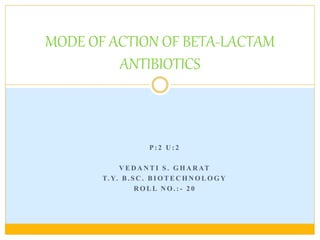
MECHANISM OF ACTION OF BETA-LACTAM ANTIBIOTICS (1).pptx
- 1. P : 2 U : 2 V E D A N T I S . G H A R AT T. Y. B . S C . B I O T E C H N O L O G Y R O L L N O . : - 2 0 MODE OF ACTION OF BETA-LACTAM ANTIBIOTICS
- 2. β- Lactams Beta-lactams comprise a large family of different groups of bactericidal compounds, all containing the beta-lactam ring. All β- lactam drugs are selective inhibitors of bacterial cell wall synthesis and therefore active against growing bacteria. The different groups within the family are distinguished by the structure of the ring attached to the beta-lactam ring – in penicillins this is a five- membered ring, in cephalosporins a six- membered ring – and by the side chains attached to these rings.
- 3. Beta-lactams contain a beta-lactam ring and inhibit cell wall synthesis by binding to cell receptors, penicillin-binding proteins(PBPs). PBPs are membrane proteins (e.g. Carboxypeptidases, transglycosylases and transpeptidases) capable of binding to penicillin (hence the name PBP) and are responsible for the final stages of cross-linking of the bacterial cell wall structure. Inhibition of one or more of these essential enzymes results in an accumulation of precursor cell wall units, leading to activation of the cell’s autolytic system and cell lysis.
- 4. PBPs are under chromosomal control, and mutations may alter their number or their affinity for β-lactam drugs. After β -lactam drug has attached to one or more receptors, the transpeptidation reaction is inhibited and peptidoglycan synthesis is blocked. The next step probably involves removal or inactivation of an inhibitor of autolytic enzymes in the cell wall. This activates the lytic enzyme and results in lysis if the environment is isotonic. In a hypertonic environment, the microbes change to protoplasts or spheroplasts, covered only by the fragile cell membrane. In such cells, synthesis of proteins and nucleic acids may continue for some time.
- 5. Within the periplasmic space of gram-negative beta- lactamases can inactive beta-lactams before they reach their target PBPs, thereby protecting the cell from antibiotic action. Alternatively, mutant PBPs fail to bind beta-lactase, thus allowing peptidoglycan synthesis to occur. In gram-positive bacteria beta-lactams may be extracellularly destroyed by beta-lactamases or rendered ineffective, as in gram-negatives, by the mutant PBPs.
- 6. The difference in susceptibility of gram-positive and gram negative bacteria to various penicillins or cephalosporins probably depends on structural differences in their cell walls (e.g., amount of peptidoglycan, presence of receptors and lipids, nature of cross-linking, activity of autolytic enzymes) that determine penetration, binding, and activity of the drugs. Resistance to penicillins may be determined by the organism's production of penicillin-destroying enzymes (beta-lactamases). Beta-lactamases open the beta-lactam ring of penicillins and cephalosporins and abolish their antimicrobial activity.
- 8. Different beta-lactams have different clinical uses, but are not active against species that lack a cell wall Some, such as penicillin, are active mainly against gram- positive organisms, whereas others (e.g., semi-synthetic penicillins, carboxypenems, monobactams, second-, third-, fourth- generation cephalosporins) have been developed for their activity against gram-negative rods. It is important to note that beta-lactams are not active against species that lack a cell wall (e.g., Mycoplasma) or those with very impenetrable walls such as mycobacteria, or intracellular pathogens such as brucella, legionella and chlamydia.
- 9. There is one group of beta-lactamases that is occasionally found in certain species of gram-negative bacilli, usually Klebsiella pneumoniae and Escherichia coli. These enzymes are termed extended-spectrum beta- lactamases(ESBLs) because they confer upon the bacteria the additional ability to hydrolyze the beta-lactam rings of cefotaxime, ceftazidime, or aztreonam. The classification of beta-lactamases is complex, based upon the genetics, biochemical properties, and substrate affinity for a beta-lactamase inhibitor (clavulanic acid). Clavulanic acid, sulbactam, and tazobactam are beta–lactamase inhibitors that have a high affinity for and irreversibly bind some beta-lactamases (e.g., penicillinase of Staphylococcus aureus ) but are not hydrolyzed by the beta-lactamase. These inhibitors protect simultaneously present hydrolyzable penicillins (e.g., ampicillin, amoxicillin, and ticarcillin) from destruction. Certain penicillins (e.g., cloxacillin) also have a high affinity for beta-lactamases.
- 10. Resistance to beta-lactams 1.Resistance by alteration in target site Methicillin-resistant staphylococci synthesize an additional PBP which has a much lower affinity for beta lactams than the normal PBPs and is therefore able to continue cell wall synthesis when the other PBPs are inhibited. 2. Resistance by alteration in access to the target site This mechanism is found in gram-negative cells where betalactams gain access to their target PBPs by diffusion through protein channels(porins) in the outer membrane. Mutations in porin genes result in a decrease in permeability of the outer membrane and hence resistance. 3. Resistance by production of beta lactamases Beta-lactamases are enzymes that catalyse the hydrolysis of the beta-lactam ring to yeild microbiologically inactive products. The beta-lactamases of gram-positive bacteria are released into the extracellular environment and resistance will only be manifest when a large population of cells is present. The beta-lactamases of gram-negative cells, however, remain within the periplasm.
- 11. There are two other types of resistance mechanisms. One is due to the absence of some penicillin receptors (penicillin-binding proteins; PBPs) and occurs as a result of chromosomal mutation; the other results from failure of the beta-lactam drug to activate the autolytic enzymes in the cell wall. As a result, the organism is inhibited but not killed. Such tolerance has been observed especially with staphylococci and certain streptococci. Examples of agents acting by inhibition of cell wall synthesis are penicillins, the cephalosporins, vancomycin, and cycloserine.